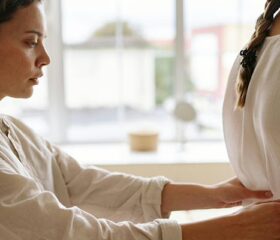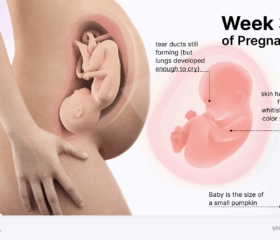Back Labor Pain: Symptoms, Causes, and How to Find Relief
Labor inevitably comes with its fair share of pain. Sometimes, this includes severe back pain, which is known as back labor.

While you’re undoubtedly excited to finally meet your baby, you might be anxious about the pain that will precede that—especially if you end up with back labor on top of everything else that childbirth entails.
Read on to learn what back labor is, why it happens, and what you can do to reduce the pain associated with it.
What is back labor?
Back labor is a specific type of back pain that some women experience when they’re in labor. While it’s normal to feel discomfort or pain in your lower back during pregnancy and childbirth, back labor is unusually severe and unrelenting pain that lessens but doesn’t stop when contractions do.
Because back labor is often caused by the position of your baby’s body, you may experience other physical symptoms as a result, like irregular contractions, slow-progressing labor, and prolonged pushing. 1
Back labor is, unfortunately, relatively common. About 33% (one third) of pregnant women report experiencing continuous lower back pain during labor. 2
Why does back labor happen?
During labor, your baby will pass through your pelvis to the vaginal opening. To make this passage, your baby’s body needs to be positioned in the smallest shape possible.
The ideal position is when her head points downward and she faces your tailbone, known as the occiput anterior or “sunny-side down” position. 3
If your baby is in the occiput posterior or “sunny-side up,” position, she’ll face the other direction, with the back of her head resting against your spine and tailbone. 4 The ensuing pressure on your bones and spinal nerves is what causes back labor.
What are the risk factors for back labor?
There aren’t many known risk factors for back labor. However, researchers have found that women are more likely to experience it when giving birth to their first child.
You may also be more likely to have back labor if you: 4
- Are obese
- Are shorter than average or have a short torso
- Have a platypelloid pelvis (a type of abnormally shaped pelvis)
Additionally, there’s a theory that back labor is more common in women who often experience severe back pain during their periods. If you’re in that unfortunate camp, it could be that your body is just extra-sensitive, making you more likely to experience this form of back pain during labor as well. 1
Back labor is less likely if you give birth earlier (preterm)
One thing that will make you less likely to experience back labor is giving birth early (when you’re between 20 weeks and 37 weeks pregnant). Experts believe that back labor is more likely to occur once you’ve passed week 40 of pregnancy. 5
What does back labor feel like?
Again, some back pain is common during pregnancy and childbirth. However, there are subtle (and sometimes not-so-subtle) differences between regular labor back pain and back labor.
Going into labor usually feels like intense menstrual cramping in your lower abdomen that comes and goes at regular intervals. As you get closer to delivery, the pain becomes more intense, and contractions come more frequently. 6
Back labor is concentrated in your lower back. The pain intensifies with contractions, but unlike regular labor pain, back labor doesn’t tend to ease up between contractions.
With back labor, many women also experience back spasms. 4
Can you prevent back labor?
Unfortunately, you can’t completely prevent back labor—it will either happen or it won’t.
With that said, you can try out a few techniques that could move your baby into an optimal position if she’s not already in place.
One technique to try is pelvic tilts. Similar to the cat-cow pose in yoga, get on your hands and knees, then curl your back so that your pelvis tilts up towards your face. 1
You could also try: 4
- Using a birth ball: A blow-up birth or exercise ball is a good way to help get your baby into position while easing lower back pain.
- Sitting with your hands up: Try sitting backwards in a chair or on the toilet with your arms up in the air, then rest your head in your arms.
- Gentle pressure: You could also have your birthing partner or midwife gently press in and up on the sides of your hips.
The good news is that most babies will naturally turn around on their own if they’re not already in the anterior position before delivery. There’s no way to guarantee this, but even if your doctor tells you that you’re likely to experience back labor, it’s possible the issue will resolve on its own.
How to minimize the pain and discomfort of back labor
Many of the strategies you can use during pregnancy to encourage your baby to get into the optimal position can also be used for pain relief when you’re in labor.
There are also other techniques you can try yourself or with the help of your doula or partner, as well as medical interventions your doctor can perform if the pain is severe.
Self-help pain relief strategies
Try standing up and walking around, or even doing gentle squats or lunges. You might also find that getting on your hands and knees (with or without a birthing ball) or lying in a spider position (on your side with your top leg bent towards your belly and supported by a pillow) is helpful.
Outside of these physical exercises, you may find that meditation or breathing exercises help you manage your pain. 1 7 8 9
Your doula or birthing partner can also give you a lower back massage or apply warm packs to your back. 8
Medical interventions
If your pain is unbearable or doesn’t ease up with self-help techniques, your doctor and medical team can administer an epidural, which will provide pain relief and allow you to save your energy for delivery.
They may also offer you: 7 8 10
- Sterile water injections: Your doctor will inject these into the skin of your lower back, providing nerve stimulation to distract you from the pain.
- Spinals: These are similar to epidurals and can instantly relieve intense pain (but only for a short while).
- Nitrous oxide: Your doctor may offer nitrous oxide (N2O) to ease the anxiety brought on by back labor, although it won’t affect the pain itself.
- Other forms of anesthesia: Your doctor might give you another form of local anesthesia in addition to an epidural, although they’ll usually only do this if you need to undergo a painful procedure (like repairing a vaginal tear) or have a medical emergency.
Are there any complications associated with back labor?
Between 10% and 34% of babies are in the occiput posterior position when labor begins. However, by the time the mom reaches the third and final stage of labor, only 5%–8% remain in this position. 11
If your baby gets stuck in a sunny-side up position, your delivery may be more difficult and require additional medical intervention. Aside from likely needing more medication, you might also: 1
- Become fatigued due to prolonged labor
- Need your doctor to provide manual assistance using forceps or a vacuum extraction
- Need to have labor induced with oxytocin
- Require an incision between your vaginal opening and anus
- Be more likely to have a C-section
- Be more at risk of early postpartum hemorrhage (an obstetrical emergency)
Are complications for your baby likely?
As far as your baby is concerned, there’s usually nothing to worry about with back labor.
Researchers have found a connection between sunny-side-up babies and lower five-minute Apgar scores (the test your doctor will perform right after your baby is born to assess her physical condition).
Your doctor will perform the Apgar test one minute and then five minutes after birth. They’ll check your baby’s breathing, heart rate, movements, crying, and other vitals.
A lower Apgar score typically doesn’t reflect your baby’s overall health. It shows that she needs more short-term attention and may require a trip to the neonatal intensive care unit (NICU) to make sure all’s well with her. 12 13 14 15
Final thoughts
While back labor is no walk in the park, it’s a sign that you’re close to meeting your baby.
Most of the time, there’s no cause for concern if your baby is in a sunny-side up position. Your doctor and medical team will be on hand to make sure you and your baby get through labor and delivery safely.
Article Sources
- American Pregnancy Association. "Back Labor" Retrieved October 20, 2025.
- American Journal of Obstetrics and Gynecology. "Low-back pain during labor" Retrieved October 20, 2025.
- MedlinePlus. "Your baby in the birth canal" Retrieved October 20, 2025.
- Cleveland Clinic. "Back Labor" Retrieved October 20, 2025.
- American College of Obstetricians & Gynecologists. "Back Pain During Pregnancy" Retrieved October 20, 2025.
- National Partnership for Women & Families. "Labor Pain Basics" Retrieved October 20, 2025.
- Office on Women’s Health. "Labor and birth" Retrieved October 20, 2025.
- U.S. Department of Veterans Affairs. "Tools for Supporting Natural Childbirth" Retrieved October 20, 2025.
- Lamaze International. "Best Labor Positions for... Back Pain" Retrieved October 20, 2025.
- Nemours KidsHealth. "Dealing With Pain During Childbirth" Retrieved October 20, 2025.
- BMC Pregnancy and Childbirth. "Maternal positioning to correct occipito-posterior fetal position in labour: a randomised controlled trial" Retrieved October 20, 2025.
- HealthyChildren.org. "Apgar Scores" Retrieved October 20, 2025.
- MedlinePlus. "Apgar Scores" Retrieved October 20, 2025.
- American Pregnancy Association. "Your Child’s First Test: The APGAR" Retrieved October 20, 2025.
- American Family Physician. "Persistent Fetal Occiput Posterior Position" Retrieved October 20, 2025.







